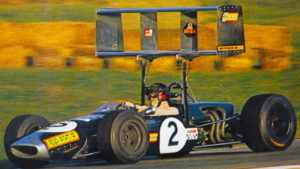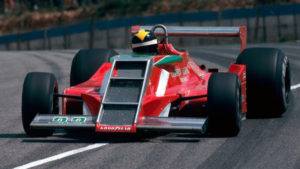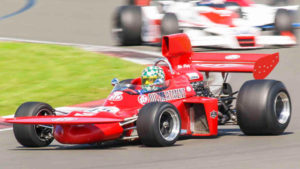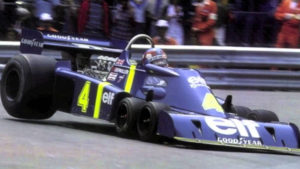Sometimes, the search for extreme technical innovations in Formula 1 has gone too far, resulting in some very ugly designs indeed. Monstrous ailerons, impossible radiators and all kinds of strange gadgets have at different times appeared on the bodies of some of the cars since the beginning of the competition in 1950.
Leading research and being at the cutting-edge of technological innovation is in Formula 1’s DNA. However, some radical designers have at times gone a little bit overboard in the aesthetics, giving the cars a certain cubist beauty.

The misunderstood ‘geniuses’ that created such eccentricities have left rivals, colleagues, press and even the public speechless with their imaginative contributions to the sport.
But as with everything in Formula 1, there is fierce competition in this search for the ugliest cars of F1 in the history. Do not be frightened by what you see below.
Brabham BT26: The super-wings
The Brabham BT26 has enough merits to be awarded a prominent place in the ugliest F1 cars’ ranking. Few could suspect at the end of the 60s, that a three-times world champion (1959, 1960, 1966) and owner of his own team, could implement such an innovation.

With the aim of improving the car’s aerodynamics, engineers installed some enormous front and rear wings. It is true that those were the early days in the field of aerodynamic research but this still seemed like a monumental step backwards.

As it was to be expected, the performance of the Brabham BT26 matched its aesthetic. The team’s drivers -Jochen Rindt and Jack Brabham– not only didn’t get a single victory during 1968 but had to abandon most of the races. This is one of the ugliest cars of Formula 1.
Ensign N179: The cheese-grater
In 1979 Dave Baldwin was perhaps dreaming of creating a revolutionary concept that would change Formula 1 forever. The resulting Ensing 179, however, nicknamed the cheese-grater, only got to be known for possessing the ugliest front of all times.

Radiators had never before been positioned outside the car and much less in that arrangement. Unsurprisingly, this led to an inefficient cooling system which overheated the cockpit.
They ended up having to replace Mr Baldwin’s great invention with a more conventional design. Their best result of the year was a 13th place in the British GP. For the rest of the season, they had to withdraw from most races due to different faults.
March 711: The ironing board
With the arrival of the 70s, the tweaking of the front wings persisted, and in some cases worsened. In fact, new wings sprouted like mushrooms almost anywhere in the car’s surface.

One of the greatest examples of this aerodynamics’ fever was the glorious March 711 of 1971. Its creators, Robin Herd and Frank Costin, installed a kind of ironing board or tea tray in the front, both nicknames for the new appendix. Despite the jokes and criticism, Niki Lauda debuted in this car and Ronnie Peterson came in second that year.

Brabham BT34
Just two years after the launch of the successful BT26, the Brabham team returned with another of its rolling wonders. It would seem as if the BT34 was a tribute to marine wildlife. Its front part resembled the claws of a lobster, nickname with which it became popular.
Two radiators were placed ahead of the front wheels, an innovation that was virtually useless. This type of motorized crustacean went through more pain than glory in 1971 and 1972.

It suffered many breakdowns and accidents during the 20 races in which it took part, only achieving a fifth place as its best result. There was nothing else that the legendary Graham Hill and Emerson Fittipaldi could have done with such a car.
Ligier JS5: The periscope
Ligier unveiled a revolutionary model for the 1976 season. Famous for a disproportionate air box, it became immediately ridiculed. Its unconventional shape soon earned it the nickname of the periscope, for its similarity with the said submarine instrument.

It took part in the first three races of 1976 (Brazil, South Africa and West USA), obtaining a third position as its best result. By the fourth race, the Spanish Grand Prix, its design, which raised 1.40 meters above ground, was prohibited.

Tyrrell P34: The legendary six wheels
The Tyrrell team developed the first six–wheel model of the F1 in 1976. It was designed by Derek Gardner, who sought to reduce the drag and increase the maximum speed.

He thought the solution lay in placing four tiny wheels on the front axle and two of conventional size ones on the rear. Its debut took place in the fourth race of the year, the Spanish Grand Prix of 1976, on May the 2nd at the Jarama Circuit in Madrid.

Despite suffering an accident in its debut race, the P34 would get its first victory three races later in the hands of Jody Scheckter at the Swedish Grand Prix in Anderstorp.
During that season, the P34 had 12 podiums! in 13 races, finishing third in the Constructors’ standings, only behind Ferrari and McLaren.

The following year, the team came with a new version of the P34. It took part in 17 GPs, only reaching the podium in three of them. As a result, the team went down to number six in the Constructors’ standings. That was the end for one of the ugliest cars in Formula 1.
Arrows A22: A slingshot on the nose of the car
Arrows introduced an extravagant solution to improve downforce issues during the free practice session of the Monaco Grand Prix in 2001. This was a triangle-shaped top wing that rested on the nose of the car.

After the tests, driver Jos Verstappen, father of Max Verstappen, gave the thumbs up to the new piece. The FIA, however, prohibited its use for security reasons. It also sanctioned the team with a $120,000 fine.

The ‘ugliest cars of Formula 1’ post: Wikipedia & Wikimedia.





Leave a Reply